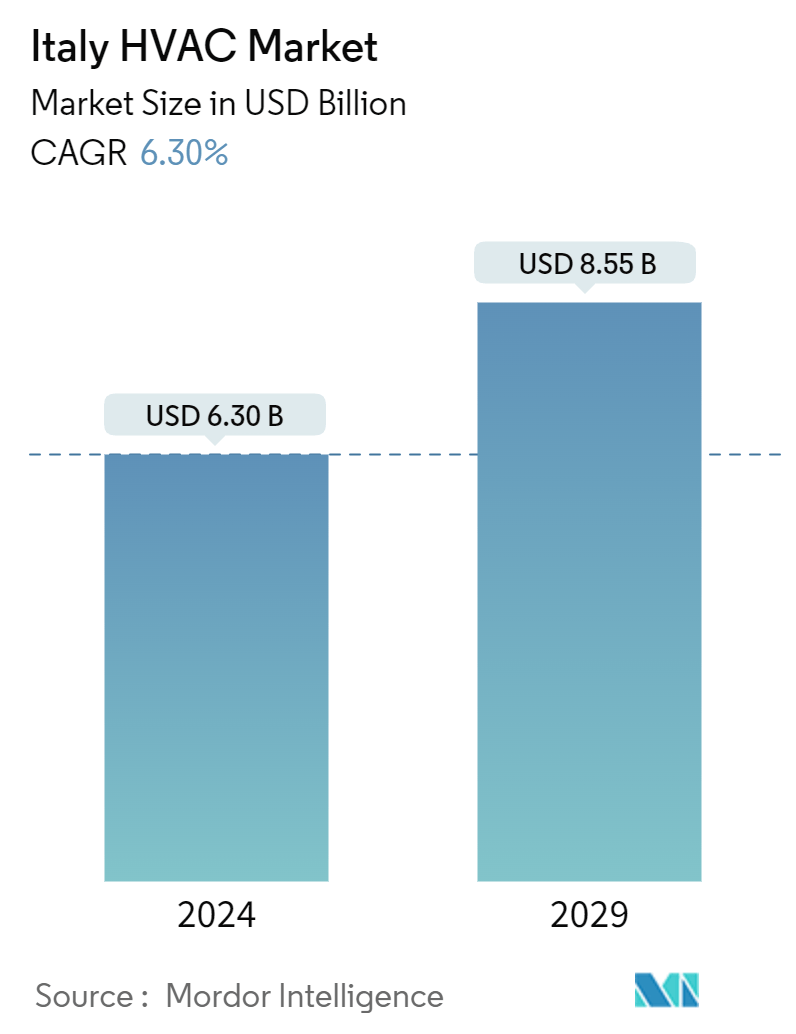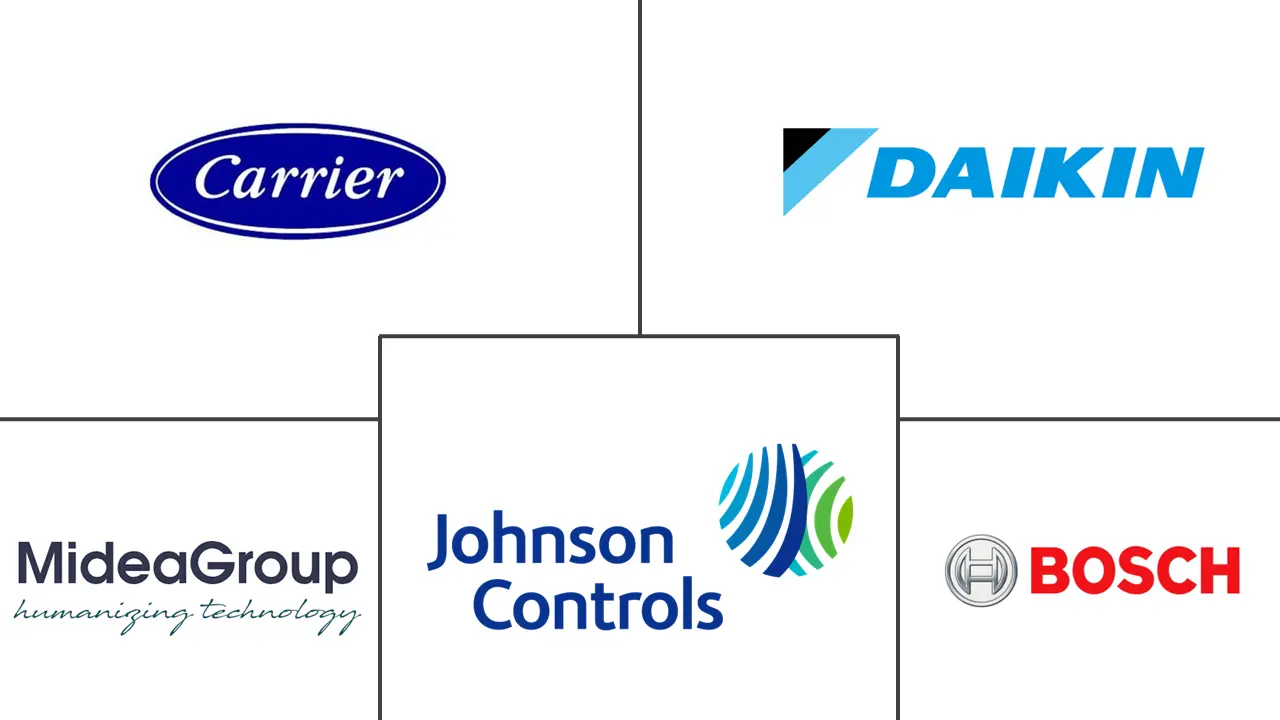Market Size of Italy HVAC Industry

| Study Period | 2019 - 2029 |
| Base Year For Estimation | 2023 |
| Market Size (2024) | USD 6.30 Billion |
| Market Size (2029) | USD 8.55 Billion |
| CAGR (2024 - 2029) | 6.30 % |
| Market Concentration | Low |
Major Players
*Disclaimer: Major Players sorted in no particular order |
Italy HVAC Market Analysis
The Italy HVAC Market size is estimated at USD 6.30 billion in 2024, and is expected to reach USD 8.55 billion by 2029, growing at a CAGR of 6.30% during the forecast period (2024-2029).
- The demand for the HVAC market will increase in Italy due to the rising expansion of industrial sectors, such as food and beverage factories, and growing investments in the healthcare and power generation sectors. According to Eurostat, the revenue from the manufacture of food products in Italy is projected to amount to approximately USD 28.59 billion by 2025.
- Furthermore, the rising expansion by food & and beverages industry players will create high growth opportunities for the service vendors operating in the country. For instance, in September 2024, Lulu Group announced opening its sourcing, food processing, and export hub in Italy. The company focuses on sourcing, processing, storing, packaging, and exporting top-quality food products from Italy to more than 255 LuLu Hypermarkets through this facility.
- Moreover, various commercial buildings in the country are replacing old HVAC systems with new ones, further expected to complement the demand for HVAC services in the market. For instance, in August 2023, Daikin announced that it had supplied three heat pump units featuring screw inverter compressors to an Italian airport—the project aimed at replacing the old HVAC system with a more modern and efficient one. A Daikin Modular P air handling unit has been installed to provide the airport with the proper ventilation.
- Energy price fluctuations directly impact HVAC system operating costs, swaying consumer choices. For many, these systems' maintenance and repair expenses are a significant deterrent. With a reluctance to embrace energy-efficient technologies, the high initial cost of HVAC equipment can be challenging for its demand. The high price may deter some customers from purchasing or upgrading the systems, impeding market expansion.
- Macroeconomic factors significantly influence market dynamics, particularly sectors like construction, government regulations, and regional initiatives to bolster infrastructure, industrial, and manufacturing domains. Notably, commercial and industrial growth fluctuations directly correlate with HVAC equipment demand. Moreover, as inflation escalates, the costs of materials, labor, and energy for HVAC system production and installation rise, often translating to higher prices for new HVAC installations.
Italy HVAC Industry Segmentation
HVAC (heating, ventilation, and air conditioning) refers to the broad array of heating and cooling systems homeowners employ to regulate indoor temperature and humidity. Beyond temperature control, these systems enhance indoor air quality through mechanical ventilation and filtration. The HVAC systems include central air conditioners, ductless mini-splits, furnaces, and boilers. Additionally, HVAC encompasses the extensive refrigeration systems found in commercial structures.
The study tracks the revenue accrued through the sale of HVAC products in the residential, commercial, and industrial sectors by various players in Italy. It also tracks the key market parameters, underlying growth influencers, and major vendors operating in the industry, which supports the market estimations and growth rates over the forecast period. The study further analyses the overall impact of COVID-19 aftereffects and other macroeconomic factors on the market. The report's scope encompasses market sizing and forecasts for the various market segments.
The Italy HVAC market is segmented by type of component (HVAC equipment [heating equipment, air conditioning /ventilation equipment], HVAC services) and by end-user industry (residential, commercial, industrial). The market sizes and forecasts are provided in value (USD) for all the above segments.
| By Type of Component | ||||
| ||||
| HVAC Services |
| By End User Industry | |
| Residential | |
| Commercial | |
| Industrial |
Italy HVAC Market Size Summary
The Italy HVAC market is poised for significant growth, driven by the expansion of industrial sectors such as food and beverage, healthcare, and power generation. The increasing demand for energy-efficient and eco-friendly HVAC solutions is further fueled by government initiatives aimed at reducing energy consumption and greenhouse gas emissions. The Italian government's financial incentives, such as the "super bonus" subsidies, encourage homeowners to invest in modernizing their properties with energy-efficient systems, thereby boosting the demand for HVAC equipment. Additionally, the replacement of outdated HVAC systems in commercial buildings and the rise of innovative technologies like heat pumps contribute to the market's expansion.
The market landscape is characterized by a fragmented structure with key players like Carrier Corporation, Daikin Industries, Ltd., and Midea Group Co., Ltd., among others, actively engaging in partnerships, mergers, and technological innovations to enhance their offerings. The focus on sustainability and energy conservation is driving the adoption of advanced HVAC solutions, with companies like L.G. Electronics Inc. and BDR Thermea Group making strategic moves to strengthen their positions in the market. As Italy continues to prioritize energy efficiency and infrastructure development, the HVAC market is expected to experience robust growth, supported by both regulatory frameworks and technological advancements.
Italy HVAC Market Size - Table of Contents
-
1. MARKET INSIGHTS
-
1.1 Market Overview
-
1.2 Industry Attractiveness - Porter's Five Forces Analysis
-
1.2.1 Bargaining Power of Suppliers
-
1.2.2 Bargaining Power of Consumers
-
1.2.3 Threat of New Entrants
-
1.2.4 Threat of Substitute Products
-
1.2.5 Intensity of Competitive Rivalry
-
-
1.3 Industry Value Chain Analysis
-
1.4 Impact of COVID-19 Aftereffects and Other Macroeconomic Factors on the Market
-
-
2. MARKET SEGMENTATION
-
2.1 By Type of Component
-
2.1.1 HVAC Equipment
-
2.1.1.1 Heating Equipment
-
2.1.1.2 Air Conditioning /Ventilation Equipment
-
-
2.1.2 HVAC Services
-
-
2.2 By End User Industry
-
2.2.1 Residential
-
2.2.2 Commercial
-
2.2.3 Industrial
-
-
Italy HVAC Market Size FAQs
How big is the Italy HVAC Market?
The Italy HVAC Market size is expected to reach USD 6.30 billion in 2024 and grow at a CAGR of 6.30% to reach USD 8.55 billion by 2029.
What is the current Italy HVAC Market size?
In 2024, the Italy HVAC Market size is expected to reach USD 6.30 billion.

